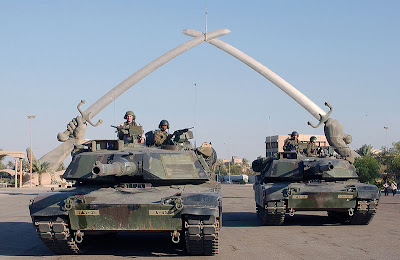Tweet
The 2003 invasion of Iraq (March 19–May 1, 2003), was the start of the conflict known as the Iraq War or Operation Iraqi Freedom in which a combined force of troops from the United States, the United Kingdom, Australia and Poland invaded Iraq and toppled the regime of Saddam Hussein in 21 days of major combat operations. The invasion phase consisted of a conventionally fought war which concluded with the capture of the Iraq capital Baghdad by United States forces.
Four countries participated with troops during the initial invasion phase, which lasted from March 19 to April 9, 2003. These were the United States (148,000), United Kingdom (45,000), Australia (2,000), and Poland (194). other countries were involved in its aftermath. In preparation for the invasion, 100,000 U.S. troops were assembled in Kuwait by February 18 The United States supplied the majority of the invading forces, but also received support from Kurdish irregulars in Iraqi Kurdistan.
According to U.S. President George W. Bush and British Prime Minister Tony Blair, the reasons for the invasion were "to disarm Iraq of weapons of mass destruction, to end Saddam Hussein's alleged support for terrorism, and to free the Iraqi people."However, former chief counter-terrorism adviser on the National Security Council Richard A. Clarke believes Mr. Bush came into office with a plan to invade Iraq. According to Blair, the trigger was Iraq's failure to take a "final opportunity" to disarm itself of nuclear, chemical, and biological weapons that U.S. and British officials called an immediate and intolerable threat to world peace. In 2005, the Central Intelligence Agency released a report saying that no weapons of mass destruction had been found in Iraq.
In a January 2003 CBS poll 64% of U.S. nationals had approved of military action against Iraq, however 63% wanted Bush to find a diplomatic solution rather than go to war, and 62% believed the threat of terrorism directed against the U.S. would increase due to war. The invasion of Iraq was strongly opposed by some traditional U.S. allies, including the governments of France,Germany, New Zealand, and Canada. Their leaders argued that there was no evidence of weapons of mass destruction in Iraq and that invading the country was not justified in the context of UNMOVIC's February 12, 2003 report. On February 15, 2003, a month before the invasion, there were worldwide protests against the Iraq war, including a rally of three million people in Rome, which is listed in the Guinness Book of Records as the largest ever anti-war rally. According to the French academicDominique Reynié, between January 3 and April 12, 2003, 36 million people across the globe took part in almost 3,000 protests against the Iraq war.
The invasion was preceded by an air strike on the Presidential Palace in Baghdad on March 19, 2003. The following day coalition forces launched an incursion into Basra Province from their massing point close to the Iraqi-Kuwaiti border. While the special forces launched an amphibious assault from the Persian Gulf to secure Basra and the surrounding petroleum fields, the main invasion army moved into southern Iraq, occupying the region and engaging in the Battle of Nasiriyah on March 23. Massive air strikes across the country and against Iraqi command and control threw the defending army into chaos and prevented an effective resistance. On March 26 the 173rd Airborne Brigade was airdropped near the northern city of Kirkuk where they joined forces with Kurdish rebels and fought several actions against the Iraqi army to secure the northern part of the country.
The main body of coalition forces continued their drive into the heart of Iraq and met with little resistance. Most of the Iraqi military was quickly defeated and Baghdad was occupied on April 9. Other operations occurred against pockets of the Iraqi army including the capture and occupation of Kirkuk on April 10, and the attack and capture of Tikrit on April 15. Iraqi President Saddam Hussein and the central leadership went into hiding as the coalition forces completed the occupation of the country. On May 1 an end of major combat operations was declared, ending the invasion period and beginning the military occupation period.

ليست هناك تعليقات:
إرسال تعليق